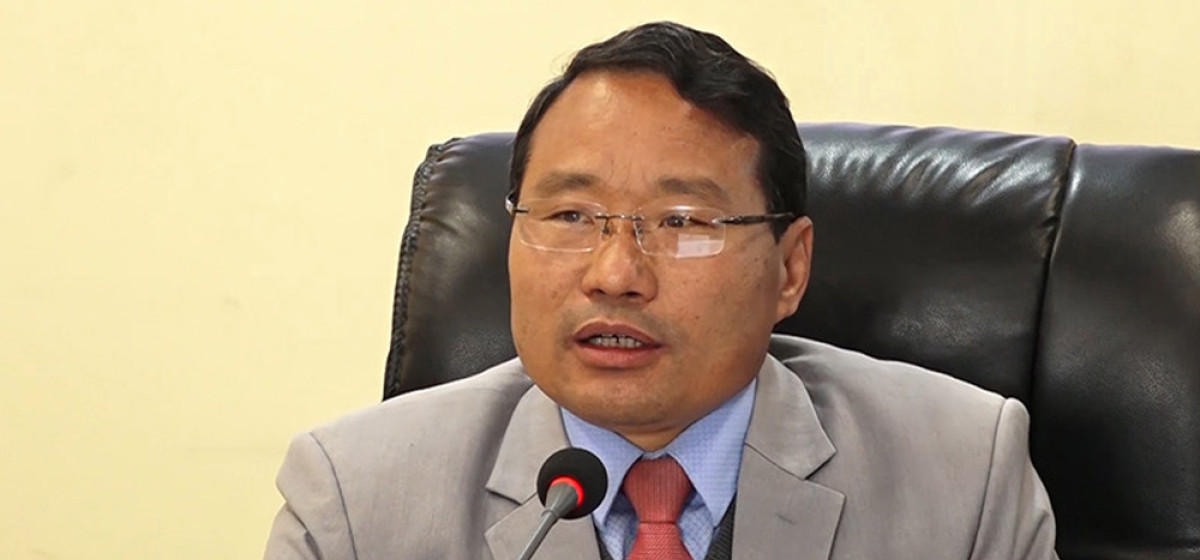
OR
Experts highlight need for intensifying diplomatic endeavors as Nepal's climate finance landscape remains poor
Published On: September 2, 2023 08:15 AM NPT By: Sajira Shrestha

KATHMANDU, Sept 2: Kagbeni, a picturesque village in Mustang district, woke up to the shock of a devastating flash flood on August 13, 2023. Besides the unfortunate toll of the disaster resulting in damages worth millions of rupees, an alarming development has emerged — a surprising surge in heavy rains and ensuing floods in Mustang and Manang, regions renowned for their rain shadow status attributed to limited rainfall.
The Department of Hydrology and Meteorology has reported a staggering 25 mm of rainfall within the 24 hours preceding the flood — an unprecedented figure for the region. Experts emphasize that such substantial precipitation in rain shadow areas cannot be deemed normal.
Similarly, the spread of mosquitoes and dengue infection, once confined to Nepal's Terai region, has now extended to the hill and mountainous regions. Disturbing reports indicate a widespread prevalence of dengue infections across all districts of Sudurpaschim Province, significantly affecting even the mountain district of Darchula. The convergence of climate change impacts and increased human movement has facilitated the migration of mosquitoes from the Terai to the mountain and hill districts of the country.
Likewise, an international report titled 'Air Quality Life Index-2023,' released on August 29, 2023, and based on 2021 data, reveals a disheartening reality: air pollution has led to a decline of 4.6 years in the average life expectancy of Nepalis. The reduction is even more pronounced in nine districts of the Terai, where locals have witnessed a decrease of 6.8 years in life expectancy. Satellite data measuring Particulate Matter (PM) 2.5 levels designates Nepal as the third most-polluted country globally.
These instances clearly underscore Nepal's vulnerability to the far-reaching consequences of climate change. Addressing climate change-related issues and mitigating associated problems require a collaborative effort that extends beyond Nepal's borders. This necessitates financial support from donor countries and organizations, which comes within the realm of climate finance.
Here, climate finance denotes financial resources provided by governments, international entities, private sector stakeholders, and other sources, with the aim of bolstering initiatives focused on adapting to and alleviating the impacts of climate change. At its core, climate finance strives to empower nations and communities to transition toward low-carbon, climate-resilient economies and societies.
Within the budget designated for the ongoing fiscal year 2023/24, 5.96 percent of the budget is directly allocated to climate-related matters, 29.90 percent holds relevance to climate considerations, and a significant 64.14 percent of the budget is classified as climate-neutral.
Nonetheless, Nepal's prevailing budgetary requisites bear a marked reliance on both internal and external loans. Among the aggregate budget requirement of Rs 1,751 trillion for the current Fiscal Year 2022-23, the government aspires to secure Rs 49.94 billion in foreign grants, representing 2.9 percent of the comprehensive budget allocation.
As per the National Adaptation Plan spanning from 2021 to 2050, Nepal is projected to necessitate a total of $47.4 billion by 2050 to execute priority adaptation initiatives. From this pool, Nepal has set a goal of accumulating $1.5 billion through internal channels, and the remaining $45.9 billion originating from external sources. The National Climate Change Policy of 2076 BS has pinpointed 64 priority adaptation programs, distributed across eight thematic and four interdisciplinary sectors.
Evidently, the implementation of Nepal's indigenous priority adaptation plan mandates an annual financial influx of $2.1 billion by 2030. Also, Nepal has aimed at attaining net-zero carbon emissions by 2045, substantiated by a phased reduction strategy. Within its second National Determined Contribution (NDC) presented to the United Nations Intergovernmental Panel on Climate Change (IPCC) in 2020, Nepal has explicitly committed to evolving into a carbon-neutral nation by 2045.
Projections suggest that the execution of the NDC by 2030 will require $33 billion. Consequently, the comprehensive financial requisites encompass $54 billion to actualize both the NDC's zero emissions goal by 2030 and the National Adaptation Plan's aspirations — delineated as $33 billion and $21 billion respectively. Accordingly, Nepal is slated to necessitate an annual funding of $5.4 billion until 2030.
An appraisal of the preceding decade indicates Nepal's allocation of $0.5 billion annually from internal and external sources as its climate budget. Regrettably, this allocation amounts to a mere 9.25 percent of the total imperative for NDC and Adaptation Plan realization.
Prabin Man Singh, program director of the Nature Resources Center, laments, "Collectively, we have succeeded in mobilizing approximately just 10 percent of the indispensable climate finance quantum."
Singh highlights that while there has been an increase in the flow of climate finance compared to a decade ago, the current resources remain insufficient for Nepal to fully honor its commitments. "In contrast to the past, both the funding quantum and the range of programs have expanded. However, they still fall short of addressing the comprehensive spectrum of climate-related challenges," he remarked.
As the frequency of climate-induced disasters continues to rise, Nepal witnesses an alarming toll on both human lives and property each year. The government's capacity to offer socio-economic assistance in the aftermath of such disasters has proven inadequate. Confronting the multifaceted challenges imposed by climate change demands substantial investments across diverse sectors, encompassing renewable energy, infrastructure development, and adaptive measures. In this context, climate finance emerges as a pivotal mechanism to bridge the gap between the available resources and the actual financial outlays required to effectively combat climate-related adversities.
"The primary aim of climate finance is to secure a designated sum for fostering new approaches across sectors like agriculture, water supply, forestry, and healthcare. The goal is to curtail the impact of climate change in countries like Nepal," adds Singh. Furthermore, climate finance serves the purpose of curbing greenhouse gas emissions. For instance, the transition from petroleum-dependent vehicles to electric ones necessitates dedicated funding. Climate finance becomes indispensable to address such financial requisites.
Climate finance stands as a fundamental objective within the framework of the Paris climate agreement. As stipulated by the Paris Agreement, a consensus was reached to ensure developed nations provide an annual financial support of $100 billion to least developed, developing, and coastal countries worldwide. According to the Organization for Economic Co-operation and Development (OECD), developed countries disbursed $83.3 billion in accordance with this commitment during 2020. However, contrasting figures emerge from another prominent international organization, Oxfam, which indicates that the assistance extended by developed nations in the sphere of climate finance amounted to a mere $21 to $24 billion in the same year.
In August 2022, Nepal's decision to enter a $100 million concessional loan agreement with the World Bank for its "green, resilient, and inclusive development" (GRID) initiative sparked widespread protests. This move drew criticism from policymakers, academia, and climate activists, who voiced their concerns and dissatisfaction with the climate loan. The experts believe that climate finance should exclusively materialize in the form of grants, vehemently opposing its manifestation as loans. They mentioned that loans could potentially perpetuate injustice towards residents of vulnerable nations who bear minimal responsibility for global warming.
Bimal Regmi, a Climate Change Specialist at the International Institute for Environment and Development (IIED), contends that although Nepal stands as one of the world's prominent nations facing climate-induced risks, it has not managed to embark on the anticipated efforts to secure requisite climate finance from external sources to combat this pressing issue. "Nepal has struggled to attract an adequate quantum of climate finance accessible at the international level. The underlying cause is the deficiency in Nepal's internal capacity. Factoring in the current institutional framework and internal capabilities, Nepal requires $6-7 billion to achieve the $47.4 billion target by 2050. Nevertheless, procuring even one billion USD within a year has proven to be challenging," he said.
The primary factor contributing to Nepal's internal capacity challenges is the exclusive oversight of climate finance and climate change matters by the Ministry of Forest and Environment. Ideally, this responsibility should be shared among diverse ministries including the Ministry of Finance and the Ministry of Foreign Affairs. “Regrettably, there appears to be limited inter-ministerial communication on this critical subject," added Regmi.
The Ministry of Forest and Environment has formulated a Climate Finance Strategy and Action Plan, which has received approval from the National Council for Environment Protection and Climate Change. However, as of now, the plan awaits presentation before the cabinet for formal endorsement. "The Climate Finance Strategy and Action Plan can only be set into motion once it receives cabinet approval," emphasized Regmi. "Therefore, expediting its endorsement by the cabinet is of utmost importance at present."
Dr Buddhi Sagar Poudel, chief of the Climate Change Management Division within the Ministry of Forest and Environment, acknowledged the evident shortfall in Nepal's receipt of adequate climate finance to effectively mitigate climate change challenges. However, he emphasized that Nepal's proactive approach encompasses both soliciting and effectively employing climate funds.
Dr Poudel highlighted that Nepal has proposed 14 projects to the Green Climate Fund (GCF), each at various stages of progress. This underscores Nepal's commitment to seizing available opportunities.
Dr Poudel further said that a fresh climate finance target is slated for establishment starting from 2025. He mentioned that discussions are underway regarding the execution of the loss and damage fund, which may soon come into effect. This anticipates that Nepal will capably assimilate these new developments into its climate finance strategy.
Simultaneously, experts emphasize that Nepal must earnestly undertake comprehensive preparations to effectively compete for climate finance on the global stage. "By establishing a robust presence across diverse international platforms, Nepal can significantly enhance its potential to secure increased funds. Equally important is the prudent utilization of acquired funds, underscoring our unwavering international commitment," remarked Singh.
Likewise, Regmi highlighted the pivotal role the private sector can play in advancing climate mitigation initiatives. "The government's encouragement of private sector involvement in climate-related projects is vital. Relying solely on foreign grants and loans may not always suffice. Private sector investments can yield more impactful outcomes. Furthermore, our repository of well-crafted plans and policies is extensive; their effective implementation is what's imperative," he explained.
As per expert analysis, Nepal's climate finance landscape currently rests on two principal funding streams. The initial model involves multilateral, bilateral, and other international organizations proposing, executing, and overseeing projects within Nepal. Notably, the United Nations Food and Agriculture Organization (FAO) and the International Union for Conservation of Nature (IUCN) have facilitated such support through the Green Climate Fund (GCF).
Conversely, the second model unfolds with Nepali organizations vying for funding and subsequently implementing projects. An example of this model is seen in the efforts of the Alternative Energy Promotion Center, which has leveraged this approach to foster clean cooking energy development through the GCF initiative. A comparable endeavor exists within the National Fund for Nature Conservation (NTNC), which is actively engaged in similar domains.
You May Like This

Federalism: learning by doing
Issues have emerged regarding effective implementation of federalism. But there is a long way to go and these issues can... Read More...

Government raising Rs 86 billion in domestic debt in final quarter
KATHMANDU, May 9: The government is raising Rs 86 billion in domestic debt in the last quarter of the current... Read More...

Aug 21: 6 things to know by 6 PM
Your daily dose of missed important news of the day. ... Read More...




Just In
- Nepal clinches thrilling victory over West Indies 'A' in T20 cricket match
- Capital Market Struggle Committee stages protest demanding protection of domestic investors (Photo Feature)
- Captain Paudel scores half-century in T20 match against West Indies 'A'
- Nine youths from Tanahu allegedly joining Russian army out of family contact for months
- West Indies 'A' sets Nepal a target of 205 runs
- Parliamentary committee directs govt to provide electricity tariff subsidies to cold storage facilities
- Former DoTM employee Bhatta arrested in connection with illegal license issuance case
- One killed in a fire incident in Dadeldhura














Leave A Comment